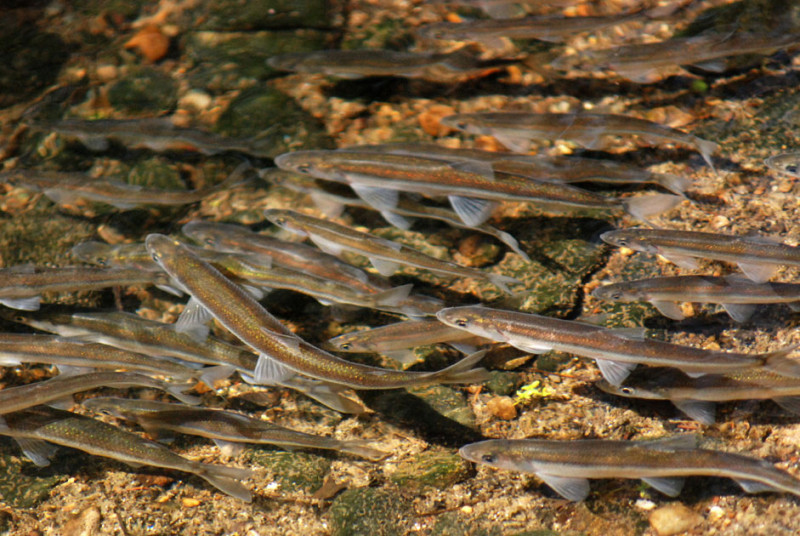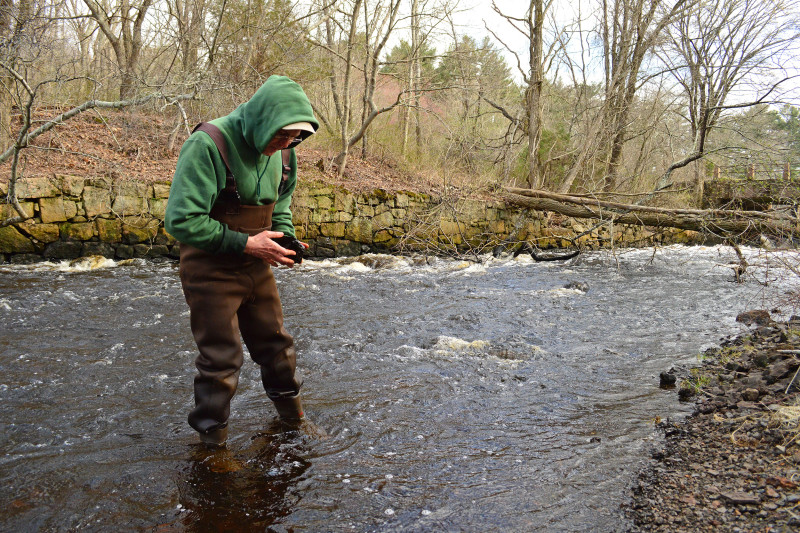On the Weweantic River, scientists search for rainbow smelt
There is a stretch of the Weweantic River in Wareham where the water ripples wildly over rocks and logs, cascading downstream on its way toward Buzzards Bay.

Rainbow smelt swim upstream in spring to spawn over rocky riffles in freshwater rivers. (Image: Tom Palmer/Neponset River Watershed Association)
This riffle, where fresh water flowing from the river’s headwaters in Carver, Middleborough, and Rochester meets the brackish tidal waters of the estuary, is a prime spot for spawning fish to visit each spring. Perch, American eels, river herring, and sea lampreys are a few of the numerous fish species that find a home in the Weweantic River.
“This is the one river where you never know what [species] you’re going to find,” according to Mike Bednarski, fisheries biologist with the Massachusetts Division of Marine Fisheries (DMF). “It’s a really cool site from a fish diversity standpoint.”
Ecological diversity is one of the reasons why the Coalition protected the land surrounding this important stretch of the Weweantic River in 2012. The property, Horseshoe Mill, is open as a public conservation area that connects with trails at Birch Island Conservation Area.
In the Weweantic, there is one particular species that biologists search for each spring. It’s called rainbow smelt: a small, silvery fish that lives its entire life in Buzzards Bay. Known for being delicious, smelt are a popular catch with anglers throughout New England. Here on the Weweantic, a few local fishermen still catch smelt with dip-nets in spring.
The Weweantic River is home to the southernmost population of rainbow smelt in the United States – a big shift from a century ago, when rainbow smelt stretched all the way south to the Chesapeake Bay. As recently as the 1960s, the Hudson River in New York supported smelt populations.
Now smelt appear to be dwindling in the Weweantic, too.
During a recent trip out to Horseshoe Mill, Bednarski and another biologist wade out to a monitoring net set up in the middle of the river. They find signs of the Weweantic’s abundant life – two little yellow perch and a fourspine stickleback – but no smelt.

Biologist Brad Chase searches for rainbow smelt eggs in the Weweantic River at Horseshoe Mill, a prime spawning area for smelt.
On another afternoon, Brad Chase, also a fisheries biologist with Massachusetts DMF, stands knee-deep in the rushing water. Again and again, he dips his bare hands into the cold water and picks up moss-covered rocks from the river bed in search of smelt eggs. He finds none, even though smelt should have started spawning here weeks ago. “To struggle to find a single egg is sad,” Chase remarks, throwing each rock back into the river with a splash.
There are a few culprits for rainbow smelt’s decline. One is nitrogen pollution, which can fuel the growth of algae that smothers eggs and fouls spawning habitat. But scientists are focusing on a bigger problem, one that’s even tougher to solve: global warming.
Rainbow smelt are adapted to thrive in colder conditions – a competitive advantage that helps the fish avoid predators in winter, when most other fish normally become sluggish. Without prolonged cold periods, smelt can’t evade their bigger, faster predators. As average temperatures have climbed in recent decades, smelt’s range has shifted northward.
If global warming is to blame for smelt’s decline, “there aren’t many good options” to bring back once-abundant populations, Bednarski says. One of the most important solutions is to protect the fish’s habitat – like this portion of the Weweantic River, which Chase says contains “one of the best stretches of smelt spawning riffles in the state.” In the coming years, the Coalition will be working to restore habitats at Horseshoe Mill to protect smelt and all the Weweantic River’s wildlife.
In the meantime, scientists like Chase and Bednarski will continue to search for signs of smelt in the rippling waters of the Weweantic.
Visit our Flickr page to see more photos of migratory fish monitoring on the Weweantic River at Horseshoe Mill.